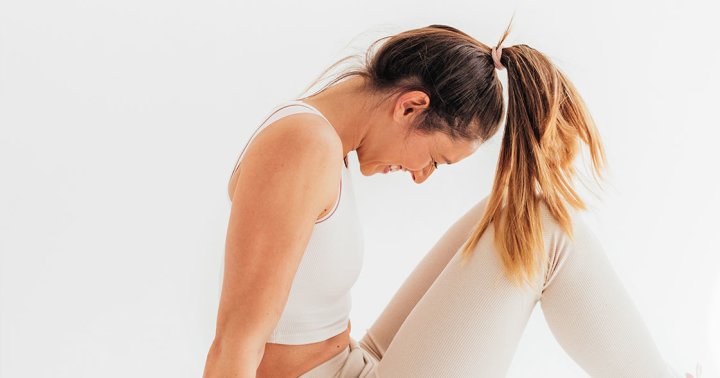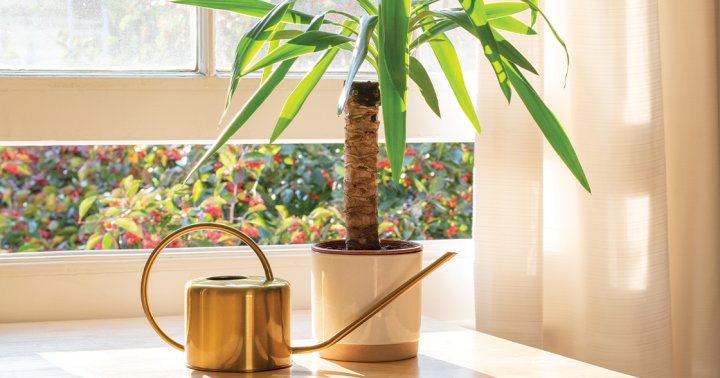Our bodies have power to influence our minds, and vice versa. This collection of guided meditations is designed to help show you how.
3 Mindfulness Practices for Mind-Body Connection
1) A Daily Mindful Walking Practice
Often, our journeys from point A to point B are times when we’re tuned out from the world around us. Maybe we listen to a podcast or get lost in our thoughts. With walking meditation, these journeys can become opportunities to gather our awareness. “Whether moving between floors of a building, on a city street, or in the woods, it is an opportunity to guide ourselves out of the distracted autopilot we live in throughout so much of our day,” says Mark Bertin.
A Daily Mindful Walking Practice
As you begin, walk at a natural pace. Place your hands wherever comfortable: on your belly, behind your back, or at your sides. If you find it useful, you can count steps up to 10, and then start back at one again. If you’re in a small space, as you reach ten, pause, and with intention, choose a moment to turn around. With each step, pay attention to the lifting and falling of your foot. Notice movement in your legs and the rest of your body. Notice any shifting of your body from side to side. Whatever else captures your attention, come back to the sensation of walking. Your mind will wander, so without frustration, guide it back again as many times as you need. Particularly outdoors, maintain a larger sense of the environment around you, taking it all in, staying safe and aware.
Now for a few minutes, expand your attention to sounds. Whether you’re indoors, in the woods, or in a city, pay attention to sounds without labeling or naming, or getting caught up in whether you find them pleasant or unpleasant. Notice sounds as nothing more or less than sound.
Shift your awareness to your sense of smell. Again, simply notice. Don’t push or force yourself to feel anything at all, just bring attention to the sense of smell, whatever you discover.
Now, move to vision: colors and objects and whatever else you see. Patiently coming back each time something grabs your attention, or even if something needs addressing, like avoiding an obstacle. Staying natural, not overly rigid, not daydreaming and drifting, but with sustained awareness.
Keep this open awareness of everything around you, wherever you are. Nothing to do, nothing to fix, nothing to change. Fully aware, and walking.
In the last moments, come back to awareness of the physical sensations of walking, wherever else your mind found itself throughout the practice. Notice your feet again touching the ground. Notice again the movements in your body with each step.
2) A Gentle Practice to Wind Down Before Bed
Gentle movement and intentional breathing can be powerful ways to let go of stress. In this calming yoga practice we stretch, breathe, and release the tension of the day to come into a place of peaceful relaxation before drifting off to sleep. You don’t need any special equipment or clothes to get the most out of this practice. Simply show up in something comfortable and find a place to spread out.
Begin by sitting comfortably—sit up tall and allow your eyes to close.
Take a few deep breaths in and out through your nose.
Set your intention to let go of the day, to practice releasing and relaxing on command and giving yourself permission to sleep.
Now, please allow your eyes to open and interlace your fingers. Turn the palms of your hands away from you and reach your arms up over your head…and release.
Interlace your fingers the other way here with your other hand on top. Then, press your palms toward the ceiling. When you’ve got your arms stretched, take a moment. Close your eyes and deepen your breathing.
Open your eyes and release your hands. Now, allow yourself to come into a gentle side lean. You may want to rock forward or backward. Your goal is to try to erase tension from the body.
And then come back up to a seated position, and we’ll lean on the other side. Often I move a little until I find a tight spot. And then once I find that tight spot, I try to send some breath into the tight spot to clear it out.
Come all the way up to your sitting position. And then I’m just going to have you change the crossing of your legs so we’re balanced here. Put the other foot in front and take a gentle, seated twist. So I’m just going to hold on to whatever I can hold on to, and use that to twist. I inhale to get nice and tall, and then I exhale to twist my upper body with my eyes closed. Every time you approach any stretch, see what parts of your body can consciously soften and let go.
Take one more breath here, and move back to a neutral position. Whenever you’re letting go of a stretch, you don’t want to pop out of it. We want to let go of all our stretches mindfully.
So then, if it feels good to move, flow into the twist on the other side. Again, in all stretches, find a comfortable spot, close your eyes, relax, release some tension, and breathe.
Release the twist.3) The HALT Practice to Tune In to What Your Body Needs
In this classic check-in practice we take a break from our day to pay attention to what our body is asking for. Beginning with H, we investigate: Am I hungry? Then A: Am I angry or anxious? L: Am I feeling lonely right now? And finally, T: Am I tired? For each prompt, Christopher Willard offers examples of mindful ways to meet your needs and restore balance.
The HALT Practice to Tune In to What Your Body Needs
Find a comfortable posture. If it works for you, you can simply allow your eyes to close, or leave them open and gently gaze downward.
H: Check in with your body for any signals related to hunger. Are you hungry in this moment? How do you know? Do you feel it in your belly? Do you feel your energy down? Do you feel that “hangry” grumpiness coming on that some of us are familiar with? Just checking in with what your body and mind might be telling you about hunger. Your brain really needs a lot of fuel, a lot of energy, especially for impulse control and emotion regulation. So giving yourself the nutrition and calories that you need physically in terms of sustenance, it’s going to help you make good decisions and more effectively regulate those emotions. If there is some bit of craving, see if you can respond rather than react to it. Maybe you can plan a healthy meal that will satisfy you both physically and emotionally.
A: Are you activated with the A of either anger or anxiety? These can be related to our fight-or-flight responses. When we’re in anger or
anxiety or more primitive parts of our brain and nervous system, when we’re activated, we can’t regulate our emotions quite so effectively. We can’t think and reason things through considering the long-term consequences of our actions. How does your body tell you that you’re angry or anxious? Where in your body and your mind are you aware of it? And then making a choice for regulating and calming your body. Perhaps taking a few breaths, extending that exhale out. Perhaps grounding yourself by pressing your feet into the ground or taking a look around you. See the shapes and colors in the room. You might tense and release your muscles—whatever helps settle your nervous system, so it’s a little bit less activated and on guard.
L: Are you feeling a sense of loneliness, that need for connection? Healthy regulation for so many humans actually starts with co-regulation with others. Our collective nervous system can ramp us up or can settle us back down. Interacting with others is almost like medicine that we need sometimes. And we know that social contact starts to build better regulation skills, boost happiness, regulate our mood, and help us take more effective perspective on the situations that are challenging us at any given moment. Checking in: Are you feeling lonely or are you feeling connected? And if there is some loneliness or longing, what simple action can you do? Can you reach out, text a friend, recall a moment of recent connection with others, or find some other way to contact someone supportive?
And lastly, T. Are you tired? Again, our brains don’t function all that well when we’re tired, whether it’s because we didn’t get sleep or whether it’s we’re overworking and we’ve reached the end of a long, busy, frustrating day. Our ability to regulate our attention, even our willpower, starts to slip away. We lose cognitive capacity. We all feel not-so-sharp when we’re tired. Maybe right now is not the moment to take a nap, but can you give yourself perhaps a bit of rest? Can you find a way to put into your schedule in the coming hours or days a bit more time to yourself to rest and recharge? Or you might find a way to give yourself a little bit more
sleep at night.
Riding a bike, lifting weights, sweating it out on a treadmill—each can be a mindfulness practice. Whatever the physical activity, instead of simply working out to master a skill or improve your condition, you can move and breathe in a way that shifts you from feeling busy and distracted to feeling strong and capable.
Read More 
Mindful Staff
February 7, 2023


 Fransebas
Fransebas 
































